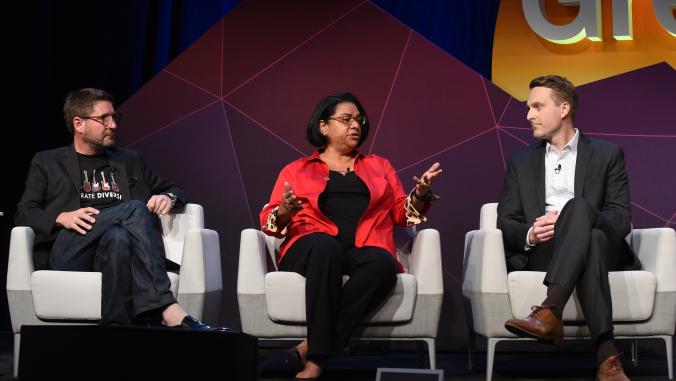Why it's time to align retirement funds with sustainability goals
A new push to move employee investments in 401(k)s and pensions to funds with high ESG ratings.

A new wave of environmentally focused retirement funds aims to advance corporate sustainability goals while enabling employees to save for their own financial future.
At its member meeting in Phoenix next week, the World Business Council for Sustainable Development (WBCSD) plans to set an aspirational goal to move 1 percent of $1 trillion ($10 billion) in retirement assets under management of its member companies to environmental, social and governance-themed retirement benefit accounts by 2020.
This includes defined-contribution (DC) plans, in which a company sets aside money each year for the benefit of their employees, and defined-benefit (DB) plans, which calculate pension payments linked to an employee's salary and how long they worked at the company.
"Several recent studies confirm that a significant majority of employees would like their company to align its social and environmental commitments with its retirement investment strategy, yet very few Fortune 500 companies do this today," said Chris Walker, WBCSD’s North American director. "Our initiative enables companies to satisfy that expectation and gain a competitive edge in the battle to attract and retain the best talent."
A significant majority of employees would like their company to align social and environmental commitments with retirement investment strategy, yet few Fortune 500 companies do.
More than half of Americans have less than $10,000 saved for retirement, and millennials — who are not only becoming the majority of the U.S. workforce, but are about to receive history's largest intergenerational wealth transfer — are 40 percent more likely than Generation X to avoid building their nest egg.
"Creating defined contribution plans which connect to millennial core values — like solving human, social and environmental problems through their work and investments — can spur employee engagement, spark innovation and provide companies with a competitive edge," wrote Tony Calandro, senior vice president of research firm Povaddo. Nearly three-quarters of Fortune 1000 company employees feel it is important to offer socially responsible investment options through their retirement plans, said Povaddo.
"Cracking the code on the 401(k) market would put ESG-themed funds squarely in front of workplace employees," Calandro said. This is especially true for the nearly 90 percent of millennials who, according to Povaddo, want sustainable investing options.
A future they can live in
Adding ESG funds to employee contribution plans allows corporations to move towards their sustainability policies and align with the United Nations Sustainable Development Goals (SDGs) and Principles for Responsible Investment (PRI), said a 2017 white paper from shareholder advocacy group As You Sow.
Between 2012 and 2016, the market for ESG-focused mutual funds and exchange-traded funds increased from $4.98 trillion to $8.72 trillion (a growth of over 133 percent), according to As You Sow. However, the $8.4 trillion in U.S. corporate DC plans poorly capitalizes on this growth; for example, only 9 percent of Vanguard's employee plans offered a single ESG option.
"It's low-hanging fruit for companies to extend ESG into retirement planning," said Andrew Behar, CEO of As You Sow. "Seventy-four percent of Fortune 1000 company employees want to invest in a future they can live in." For some, it may be fossil fuel-free, for others it could be gender equity and for others, a weapons-free fund.
The Department of Labor lifted a legal roadblock towards environmentally savvy retirement in 2015.
As You Sow illustrated the success that Stok, a real estate services firm, experienced when it began offering fossil-free fund options that also were screened for financial performance. Previously, 14 percent of Stok's employees participated in a 401(k) option, with an individual contribution rate of 1.6 percent.
Among employee's voiced concerns: "It doesn't make sense for me to invest my hard-earned money into business models that are destroying the future."
After partnering with HIP Investor's mutual fund ratings and Communitas Financial Planning to offer ESG funds that exceeded performance indicators, within two years employee retirement plan participation jumped to 95 percent with a contribution rate of 7.1 percent. Now, more than 75 percent of Stok's employees invest their 401(k) plan to be completely fossil-free.
A reflection of personal values
"This is a bit of a nirvana," said Ed Farrington, executive vice president with Natixis Investment Managers, which has a portfolio of $961.1 billion assets under management. "The most important thing that could happen is solving the problem of having to live in retirement and if the investment menu acts as an incentive tool."
People generally believe that they'll retire at 63 and estimate that they need $880,000 to fund a retirement of 20 or more years, according to a 2016 Natixis survey (PDF) of about 1,000 401(k) plan participants. But 65 percent of participants only contribute between 1 percent to 7 percent of their salary to their retirement plan. This is where incentives such as ESG alignment come in to override obstacles such as personal or tuition debt.
The Natixis survey found that 83 percent of women, closely followed by 79 percent of men, want their investments to reflect personal values. More than 60 percent of both genders indicated they would be more likely to contribute retirement contributions if the funds were doing social good. The biggest interest came from millennials aged 18-34, who will comprise 75 percent of the workforce by 2025.
In 2017, Natixis introduced the first ESG-based target funds for the 401(k) market, the Natixis Sustainable Future Funds, built around 10 funds based on criteria such as fair labor, anti-corruption, human rights and environmental impact, with $2.5 million of total net assets.
The risks include selling a security "when it could be disadvantageous to do so or forgo opportunities in certain companies, industries, sectors or countries."
Make retirement great again
The Department of Labor (DOL) lifted a legal roadblock towards environmentally savvy retirement in 2015. The DOL approved ESG investments in retirement plans, overturning a 2008 law that prevented companies from putting money into community development funds and other targeted investments without fear of being penalized for the view that they would compromise returns. These were "antiquated reasons" stemming from an impression (prevalent in the U.S.) that socially responsible investments underperform, Farrington said.
"Investing in the best interests of a retirement plan and in the growth of a community can go hand-in-hand," said U.S. Secretary of Labor Thomas E. Perez in a DOL press release about the decision. Because of improved metrics and tools linking climate and governance catastrophes to increased risk, the DOL concluded that the previous law "unduly" discouraged fiduciaries from considering ESG factors.
According to As You Sow, the top three fossil-free funds are Parnassus Endeavor Investor, Calvert Equity A and Amana Growth Investor.
Even the Trump administration's stance against environmental responsibility hasn't slowed the ESG investing train. From January to July 2017, the $3.5 billion of U.S.-based retail ESG funds and ETFs surpassed the flow from all of 2015, reported Fortune. And for good reason: companies that adhered to social and environmental standards showed better operational and stock performance, wrote Audrey Choi, Morgan Stanley's chief sustainability officer.
"The primary consideration for U.S. plan sponsors is that they perform their fiduciary duty and maximize outcomes for beneficiaries," said Alex Bernhardt, U.S head of responsible investment for human resources consulting firm Mercer. As a result, "we're seeing a huge global adoption of ESG investing," including in the U.N. PRI, which now has nearly 2,000 signatories.
Climate-smart savings
In 2017, Bloomberg announced that it was the first U.S. domiciled company to become a U.N. PRI signatory as a corporate pension plan sponsor (it was a signatory since 2009 as a service provider). It took about four to five years to get key decision-makers comfortable including an ESG-themed fund in the lineup, said Lee Ballin, head of sustainable business at Bloomberg, an effort led by the Global Benefits Team to align the investment and retirement committee; senior business leaders; legal counsel; the professional development team and investor and retirement consultants.
"The Bloomberg investment committee decided to include an ESG-themed fund [the Parnassus Core Equity Fund] into its corporate retirement plan after a thorough review of its pension plan lineup," said Cathy Bolz, Bloomberg's global head of benefits. "It was fundamental, however, that the ESG-themed fund met the same rigorous criteria like any other fund in the plan lineup."
It was fundamental that the ESG-themed fund met the same rigorous criteria like any other fund in the plan lineup.
Incorporating sustainability into Bloomberg's operations overall has improved operating margins, minimized risk and saved the organization $95 million, said Ballin.
"This is not a fad," said Ballin. "ESG is good business."
According to As You Sow, the top three fossil-free funds are Parnassus Endeavor Investor, Calvert Equity A and Amana Growth Investor.
There are multiple benefits towards investing retirement plans in ESG funds, Mercer's Bernhardt said. One is to increase the ability to have an impact on sustainability-related issues; another is that it can potentially improve retirement income.
"The biggest challenge in companies is bandwidth and education. It requires work to take place across several departments; sustainability, benefits and human resources all need to be engaged to some degree," he said. "It's not a revolutionary process, but evolutionary."





